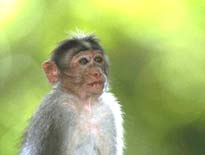Natural Habitat
Bonnet macaques are found only in India, occupying wet lowland to dry deciduous forest, at a height of upto 2100 m.
Diet
The diet of Indian bonnet macaques consists of fruits, nuts, seeds, flowers, invertebrates and cereals.
Behavior
 Bonnet macaques of India are quite sociable and are seen mostly in
groups, which comprise of both males as well as females. There can be
upto 12 males in a group and the number of females can go upto 15. They
live in their own marked territory and defend it very fiercely. Diurnal
in nature, Indian Bonnet macaques frequently sleep in fig trees near
human settlements or tall trees with dense foliage.
Bonnet macaques of India are quite sociable and are seen mostly in
groups, which comprise of both males as well as females. There can be
upto 12 males in a group and the number of females can go upto 15. They
live in their own marked territory and defend it very fiercely. Diurnal
in nature, Indian Bonnet macaques frequently sleep in fig trees near
human settlements or tall trees with dense foliage.Mating Behavior
The gestation period of female Bonnet macaque is approximately 165 days. The number of offspring born is only one, which weighs around 400 gm at the time of birth.
Status
There is a large population of Bonnet macaques in India. Thus, they are not listed as an endangered species.
Subspecies of Bonnet Macaque


